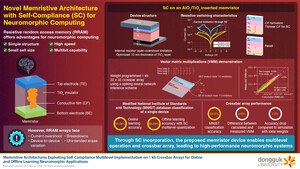Dongguk University Researchers Design a Neuromorphic Device Resembling Human Brain
SEOUL, South Korea, Feb. 9, 2022 /PRNewswire/ -- Scientists at Dongguk University have designed a novel optoelectronic device with a dual function of memory storage as well as processing. In this Internet of Things (IoT) era, massive amounts of data are produced, collected, and transmitted through devices in real time. The separation of memory and data processing units adversely affects the smooth functioning of optoelectronic devices. South Korean scientists have now designed a predictable optoelectronic device—a multi-functioning "memtransistor"—to address these limitations.
The current computing systems which have separate memory and processing devices cause excess energy consumption and slow down data transmission. Interestingly, even state-of-the-art 2D memtransistors—devices that can collect, store, and process information—exhibit sub-optimal electronic properties, such as unusually high operating voltages.
To overcome these limitations, scientists at Dongguk University designed a predictable multi-functioning memtransistor. Their paper, which was made available online on November 5, 2021 and was published in Volume 5, Issue 12 of Small Methods on December 13, 2021, described how they fabricated a highly efficient optoelectronic and memory device using two-dimensional (2D) materials—nanomaterials that are merely one or two atoms thick—by stacking 2D tellurium flakes on a thin rhenium disulfide flake, followed by the deposition of an aluminum oxide layer.
According to senior author, Dr. Hyunsik Im, who works as a Professor at Dongguk University, the team has developed an "Electrically and optically tunable p-n junction memtransistor fabricated with an Al2O3 encapsulated 2D Te/ReS2 van der Waals (vdW) heterostructure. This combines the favorable optical and electrical properties of p-type 2D Te and n-type ReS2 semiconductors, with a stable Al2O3 charge trapping layer."
In this optoelectronic memory device, multiple resistance states can be tuned by applying different voltages, or light powers. The transition between the high or low resistance states is controlled by carriers trapped in the Al2O3 layer under high electric fields. This causes an additional gate bias that tunes the Schottky barrier height at the ReS2/source electrode interface, while preserving p-n junction behaviors during the switching process, giving the device the added benefit of being electrically conductive, while being able to store memory efficiently.
Quite remarkably, this novel device is material-independent and scalable. Moreover, it allows the integration of additional electronic circuits for neuromorphic computing—a set of processes that attempt to mimic the brain's architecture and data processing capabilities.
"The development of these highly efficient memtransistor-based synaptic devices can decrease circuit complexity and minimize power consumption for neuromorphic computing and visual information processing. Mimicking synaptic activities in the human brain could become a much more manageable task in the near future," says Prof. Im
The architecture of the human brain continues to inspire nanomaterial researchers. Meanwhile, let's raise a toast to the research team for this 'brainy' achievement!
ReferenceZ
Title of original paper: Electrically and Optically Controllable p–n Junction Memtransistor Based on an Al2O3 Encapsulated 2D Te/ReS2 van der Waals Heterostructure
Journal: Small Methods
DOI: https://doi.org/10.1002/smtd.202101303
About Dongguk University
Website: http://www.dongguk.edu/mbs/en/index.jsp
Contact:
Hyunsik Im
+82 2-2260-3740
[email protected]
SOURCE Dongguk University

WANT YOUR COMPANY'S NEWS FEATURED ON PRNEWSWIRE.COM?
Newsrooms &
Influencers
Digital Media
Outlets
Journalists
Opted In






Share this article